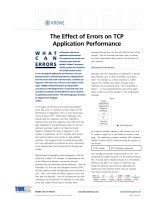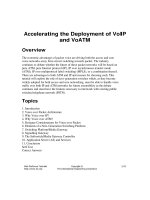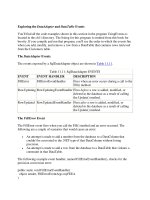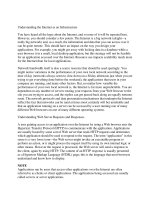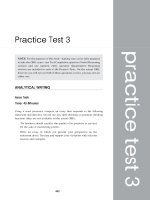Tài liệu PHP: The Good Parts: Delivering the Best of PHP- P4 docx
Bạn đang xem bản rút gọn của tài liệu. Xem và tải ngay bản đầy đủ của tài liệu tại đây (312.63 KB, 20 trang )
The second line of output, the single use of MD5, does not change on a page refresh,
while the other content does.
There is more detailed discussion on the MD5 function (and its more
secure cousin sha1) in Chapter 9 on security.
PHP provides many more string functions, and over time you may choose to become
familiar with many of them. The string functions we have covered here are those that
you are likely to find the most beneficial right away. In the next chapter, we will follow
a similar pattern with a discussion of arrays.
String Functions (Best of) | 43
Please purchase PDF Split-Merge on www.verypdf.com to remove this watermark.
Please purchase PDF Split-Merge on www.verypdf.com to remove this watermark.
CHAPTER 5
Arrays
Now that we have a handle on the concept of strings, let’s take a look at the power and
flexibility of arrays. Arrays are known as compound data types; all that really means is
that they are more complex in structure than simple strings and integers, which are also
known as scalar data types. Imagine an array as an egg carton. It carries 12 individual
compartments that can house one egg each, yet it travels around as one entity. The
compartments can be broken off and made into single egg holders, or holders in any
number combination. Additionally, these compartments are not limited to holding only
eggs; they can hold rocks, or cookies, or match sticks. Of course, an analogy like this
has its limitations—egg cartons cannot easily be expanded and they cannot hold other
egg cartons, all of which, we will see, arrays are excellent at doing.
Let’s talk more precisely about arrays. Like egg cartons, arrays have compartments
(elements) that hold data. The elements and their respective data always travel together
(although you can have an empty element without data) and are known as key/value
pairs. So, if we had an array of five elements, each containing a number in the range
from 1 to 5, it would look like Table 5-1 (elements start their counting with 0).
Table 5-1. Visual representation of an array with numeric (indexed) keys
Keys 0 1 2 3 4
Values
1 2 3 4 5
Indexed Arrays
Arrays with numerical keys are known as indexed arrays. The keys can also be named
with strings, if you prefer, creating what is known as an associative array, as you will
see later in this chapter. Let’s consider an array called
$myArray
.
Array variable names follow the same naming rules as regular PHP var-
iables (see the section “Variables: Data Types, Loose Typing, and
Scope” on page 9).
45
Download at Wow! eBook
Please purchase PDF Split-Merge on www.verypdf.com to remove this watermark.
In PHP code, you can reference the elements of an array by their keys, surrounded by
square brackets. If we want to take the value of the third element of the array—the
contents being the number 3 in this case—and assign it to its own variable, the code
would look like this:
// remember, the elemets of the array start with 0
$singleValue = $myArray[2] ; echo $singleValue ; // output would be 3
Now, this assumes that we have already defined the array somewhere else in our code.
There are two ways in which to create arrays; the first is a variation on the use of the
square bracket syntax. Here is the code for creating an array with this method:
$myArray[0] = 1 ;
$myArray[1] = 2 ;
$myArray[2] = 3 ;
$myArray[3] = 4 ;
$myArray[] = 5 ;
This method assumes that we already know the key order and their values, as the key
numbers here are hardcoded. Notice that the last line of code in the above example is
not “forcing” the key number inside the square brackets; when this is done (not pro-
viding the key number), the result is that the next available integer key will be assigned
to that element for us.
Creating an array in this fashion may or may not be what you want. The other method
available is to use the array function with the key/value pairs passed together and
separated by commas, like so:
$myArray = array(0 => 1, 1 => 2, 2 => 3, 3 => 4, 4 => 5) ;
This way of creating an array is much more condensed, yet it may be a little more
difficult for humans to read.
If you want to create an empty array, just use the array function without any parameters:
$a = array()
The keys of any array have to be named uniquely, otherwise there would
be
confusion when referencing their contents. PHP won’t prevent you
from using the same key multiple times in an assignment, but each
identical key assigned will replace the one before it.
Associative Arrays
So far we have looked at indexed arrays, but as I mentioned before, the key portion of
an array can also consist of character strings. The data values that we have looked at
so far have also been numerical, but these too can be changed to string data, as shown
in Table 5-2.
46 | Chapter 5: Arrays
Please purchase PDF Split-Merge on www.verypdf.com to remove this watermark.
Table 5-2. Visual representation of an array with named (associative) keys
Keys first second fname initial lname
Values
1 2 Peter B MacIntyre
To create the array represented in Table 5-2, use the same code syntax options as before,
but with appropriate alterations for the strings:
$myArray['first'] = 1 ;
$myArray['second'] = 2 ;
$myArray['fname'] = "Peter" ;
$myArray['initial'] = "B" ;
$myArray['lname'] = "MacIntyre" ;
Alternately, you can use the following:
$myArray = array('first' => 1, 'second' => 2,
'fname' => "Peter", 'initial' => "B", 'lname' => "MacIntyre") ;
There is no real difference here between the use of single or double quotes, and as you
can see, they are interchangeable. Just be careful with them when escaping special
characters or variable contents in the same way you would with regular string man-
agement (see “The Great Escape” on page 34).
You can reference the array’s elements the same as you would an indexed array, again
using the string instead of a number. So, if you want to echo out your full name using
the contents of this array, write the following code (with some string formatting added
in for clarity):
echo $myArray['fname'] . " " . $myArray['initial']
. " " . $myArray['lname'] ;
Arrays from Another Dimension
The data types that can be held within the elements of arrays are the same as those that
can be held within a regular variable: integers, strings, dates, Booleans, and so on. One
really great thing about arrays, though, is that their elements can also hold other arrays,
thus making them multidimensional. There is no limit to the depth arrays’ dimensions,
but after about three levels, it can become difficult to keep the elements and their keys
straight. Here is some code showing a two-dimensional array:
$myArray['first'] = 1 ;
$myArray['fruit'] = array("Apples", "Oranges", "Tomato") ;
$myArray['fname'] = "Peter" ;
$myArray['initial'] = "B" ;
$myArray['lname'] = "MacIntyre" ;
var_dump($myArray);
Arrays from Another Dimension | 47
Please purchase PDF Split-Merge on www.verypdf.com to remove this watermark.
It’s a good idea to familiarize yourself with two-dimensional arrays, as
they are the main structural representation of database results. More on
that in Chapter 7.
To make reference to the elements of a second (or deeper) dimension, just continue
with the square brackets concept. To refer to the element in our example that contains
the string “Tomato,” do this:
echo $myArray['fruit'][2] ;
Remember that the elements are counted beginning with zero, so you will need to ask
for element 2 to get the third one. This is true even though we assigned strings to both
the keys and the values. And yes, a tomato is a fruit!
Arrays Can Be Dynamic
As you have probably already realized, arrays in PHP are dynamic. This means that
with the use of the right code commands and functions, you can add elements to an
existing array without much effort. You can also delete elements from an array just as
easily. In fact, you can do a lot of things to arrays (more of which we will examine later
in this chapter), but for now let’s just look at adding to and taking away from them.
To add an element to the end of an existing array, simply use the empty square brackets
approach.
If you are adding to the end of an associative array and fail to provide a
key,
PHP will add the element with the next highest index value, thus
making a mixed index and associative array.
Let’s look at some code:
$myArray = array('first' => 1, 'second' => 2,
'fname' => "Peter", 'initial' => "B", 'lname' => "MacIntyre") ;
echo $myArray['fname'] . " " . $myArray['initial']
. " " . $myArray['lname'] ;
echo "<br/>" ;
$myArray[] = "555-5678" ;
var_dump($myArray) ;
Here, we add a new value (a phone number) to the end of the array, but because we do
not provide a key, when we var_dump the array we get output showing that the last
element in the array has the key of 0, which is the next numerical index value in this
particular array. If we want to avoid this behavior, we simply add an associative key to
the command ($myArray["phone"] = "555-5678" ;) :
48 | Chapter 5: Arrays
Please purchase PDF Split-Merge on www.verypdf.com to remove this watermark.
Peter B MacIntyre
array(6) { ["first"]=> int(1) ["second"]=> int(2) ["fname"]=> string(5) “Peter”
["initial"]=> string(1) “B” ["lname"]=> string(9) “MacIntyre” [0]=> string(8) “555-5678”
}
One
option for removing an element from an array is the array_splice function. This
is a very powerful function with a number of different options, so be sure to look more
deeply into its use with the help of the php.net website. Here, we just want to remove
the last element of the array: the phone number element that we added before. To do
that, we can write code like this:
$myArray = array('first' => 1, 'second' => 2,
'fname' => "Peter", 'initial' => "B",
'lname' => "MacIntyre", 'phone' => "555-5678") ;
var_dump($myArray) ;
echo "<br/>" ;
array_splice($myArray, 4);
var_dump($myArray) ;
The result of var_dump on the array now looks like this:
array(6) { ["first"]=> int(1) ["second"]=> int(2) ["fname"]=> string(5) “Peter”
["initial"]=> string(1) “B” ["lname"]=> string(9) “MacIntyre” ["phone"]=> string(8)
“555-5678” }
array(5) { ["first"]=> int(1) ["second"]=> int(2) ["fname"]=> string(5) “Peter”
["initial"]=> string(1) “B” ["lname"]=> string(9) “MacIntyre” }
The first option in the array_splice function is the array to be worked on, and the
second option is the array position with which to start the work. In this case, we are
telling PHP to remove the fifth element from this array. Notice that we are using the
index position value here, 4, and not the key value of 0. You can use a conditional third
option, length, which indicates how many elements this work should be performed on.
Since our code does not use this option, the default action is to perform the task on the
last element of the array. If you want to maintain the original array and make a new
one that will hold the result of the array_splice function, simply assign the result to a
new variable and array_splice will create a completely new array for you. We can
change the code to remove all the contents of the array that have to do with my name
and place them into a new array with the following code:
$myArray = array('first' => 1, 'second' => 2,
'fname' => "Peter", 'initial' => "B",
'lname' => "MacIntyre", 'phone' => "555-5678") ;
$name_array = array_splice($myArray, 2, 3);
var_dump($myArray) ;
echo "<br/>" ;
var_dump($name_array) ;
The output would be thus:
Arrays Can Be Dynamic | 49
Please purchase PDF Split-Merge on www.verypdf.com to remove this watermark.
array(3) { ["first"]=> int(1) ["second"]=> int(2) ["phone"]=> string(8) “555-5678” }
array(3) { ["fname"]=> string(5) “Peter” ["initial"]=> string(1) “B” ["lname"]=> string(9)
“MacIntyre” }
Notice
here, too, that the array_splice function leaves the phone number as the last
element in $myArray, effectively lifting out the elements that have to do with the name.
This is accomplished with the third option (the limit option) in the array_splice
function.
Another way to manipulate arrays in this fashion is to use the unset function. It is
actually more efficient and a little simpler to use than array_splice. If we want to
remove the middle initial from the array above, we would code the following to remove
it from the array:
unset($myArray['initial'] ;
Traversing Arrays
Before we get into the listing of the best array functions, we need to look at ways to
easily walk through, or traverse, an array. If you read Chapter 2, you might remember
that we skipped over a flow control structure and put it on the shelf until this chapter.
That flow control structure is the foreach construct, and it has great value and use in
the context of arrays. It will allow you to step through each element of a supplied array
and implement almost any code on the key/value pairs. In addition, this construct will
place the key and value of each iteration into their own variables. Using our array sample
from before, let’s go through each key/value pair and echo each one out onto the screen.
We can do that with this code:
$myArray = array('first' => 1, 'second' => 2,
'fname' => "Peter", 'initial' => "B",
'lname' => "MacIntyre", 'phone' => "555-5678") ;
foreach ($myArray as $key => $value) {
echo "the Key is: " . $key . " and its value is: " . $value . "<br/>";
}
And the produced output is like this:
the Key is: first and its value is: 1
the Key is: second and its value is: 2
the Key is: fname and its value is: Peter
the Key is: initial and its value is: B
the Key is: lname and its value is: MacIntyre
the Key is: phone and its value is: 555-5678
If you are only interested in the values of the array, you can still use the foreach construct
and leave out the key portion: foreach ($myArray as $value). It will ignore the key
portion of the element and provide you with just the corresponding values. Alternately,
50 | Chapter 5: Arrays
Please purchase PDF Split-Merge on www.verypdf.com to remove this watermark.
